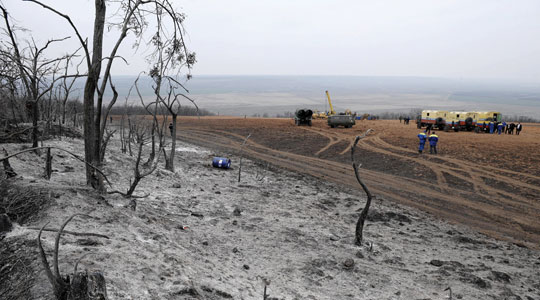
Blast Reminds the EU of Moldova-Balkans Gas Transit Pipeline
Publication: Eurasia Daily Monitor Volume: 6 Issue: 65
By:

Deliveries of Russian natural gas to Balkan countries via Ukraine and Moldova are down by approximately one half, following the April 1 explosion on the transit pipeline in Moldova. The blast is attributed to a landslide that followed days of heavy rain. It crushed the pipeline near the point where it crosses onto the right bank of the Nistru River from the secessionist-controlled left bank. The explosion, in an open field, caused a 150 meter high flame but no casualties. Two parallel backup lines do not seem to have been affected. Repair work on the ruptured section is expected to take several days (Basapress, April 1, 2).
This line normally carries 22 billion cubic meters of Russian gas annually, from a design capacity of nearly 30 billion cubic meters. The accident has refocused attention on this pipeline, which figures rarely on the European energy security agenda, notwithstanding the massive volume of Russian gas it transports to Romania, Bulgaria, Macedonia, Greece, and the European part of Turkey. This volume is on the same order of magnitude as that of the Yamal-Europe pipeline through Belarus and Poland, which carries some 24 billion cubic meters annually, from a design capacity of 33 billion cubic meters.
The pipeline, Ananiyv-Tiraspol-Izmail, crosses from Ukraine (where it forms part of the Naftohaz system) into Moldova’s Transnistria territory, continues through Moldovan-controlled territory, re-enters Ukraine in the Odessa region, and onward via Romania to the Balkan countries. According to Moldovagaz president Aleksandr Gusev, the section in Moldova was built in 1988 for a service life of 40 years and was last checked in 2008 (Moldpres, April 1, 2).
The explosion occurred between the villages of Chitcani and Copanca on the right bank of the Nistru, where the secessionist authorities from the left bank claim jurisdiction against the Moldovan government. Although the government rejects that claim, this segment of the transit pipeline is operated and maintained by the secessionist authorities’ pipeline-operating company, TiraspolTransGaz.
The two parts of Moldova consume an annual total of 2.5 to 2.7 billion cubic meters of gas on average, with Russia being the sole supplier. Transnistria, with only 15 percent of Moldova’s population, consumes approximately one half of that annual volume, mainly at industrial plants unlawfully taken over by Russian capital. Gazprom is running separate accounts for the gas consumed in Transnistria and on Moldovan-controlled territory, respectively. The Moldovan government is paying the gas bills to Gazprom every year in full.
In Transnistria, however, the secessionist authorities and industrial consumers owe $ 1.8 billion to Gazprom in debts accumulated for more than a decade. That amount is expected to increase by $350 million this year alone, thus surpassing the $2 billion mark by the end of the year, according to Transnistria’s "industry minister" Pyotr Stepanov. TiraspolTransGaz, is legally responsible to Gazprom for those debts. Gas consumption in Trasnistria has been heavily subsidized from year to year. In the first quarter of 2009, for example, TiraspolTransGaz paid to Gazprom $318 per one thousand cubic meters, then distributed that gas at only $109 per one thousand cubic meters to industrial consumers, and a mere $30 per one thousand cubic meters for household consumption (Interfax, February 5).
Transnistria’s debts to Gazprom are of the same order of magnitude as the debts claimed by Gazprom from Ukraine. Moreover, its debts can be traced unambiguously to a system of subsidies created and perpetuated by the Kremlin and Gazprom themselves. Nevertheless, Russia chooses to single out Ukraine for debt collection, triggering quasi-annual crises under that pretext, while making no attempt whatsoever to collect debts from Transnistria.
Apart from clear geopolitical reasons, shadowy business arrangements also play a role in Transnistria’s case. The Kremlin-friendly steel magnate Alisher Usmanov is said to be the dominant shareholder in the Ribnita steel plant (with Ukraine’s Rinat Akhmetov rumored to be the second-largest shareholder) while Russia’s Unified Energy System electricity monopoly "privatized" the Kuchurgan power plant. These are the main gas-consuming enterprises in Transnistria. Several years ago, the Russian government awarded to Usmanov officially the right to collect a large portion of Transnistria’s debts to Gazprom. That arrangement remained on paper, however. GazpromBank itself has a branch office in Tiraspol, but the office is managed by members of the secessionist leader Igor Smirnov’s family.
On April 2 the European Union’s Gas Coordination Group met in Brussels to examine the situation on the Moldovan section of the transit pipeline. The countries directly affected by the accident are members of the EU and/or of the European Energy Community. The Group’s meeting concluded that the accident reconfirms the necessity of building interconnector pipelines and devising emergency mechanisms to cope with supply interruptions, as envisaged in the European Commission’s November 13, 2008 directive and March 2009 infrastructure-building and economic stimulus package (NewsIn, April 3). The funding in the March package, however, looks wholly inadequate in relation to the declared goals.




